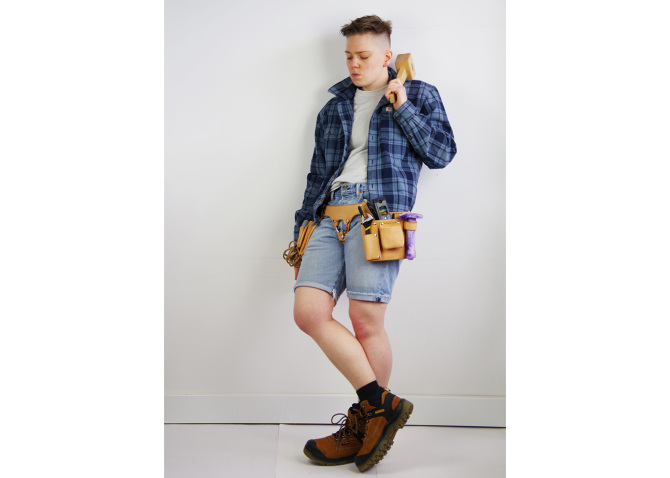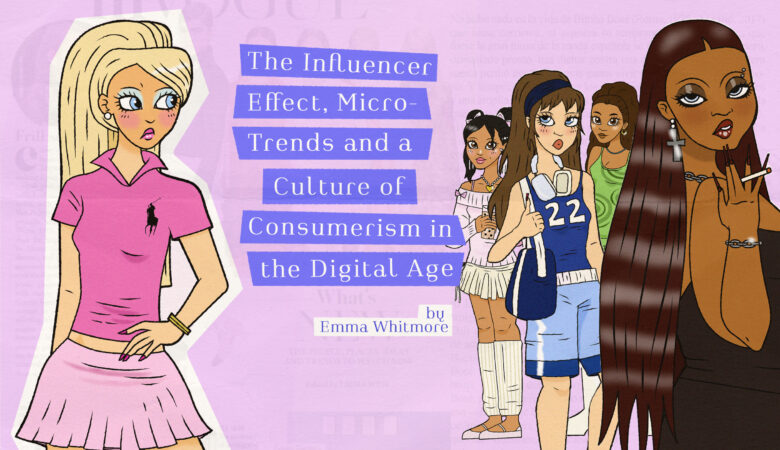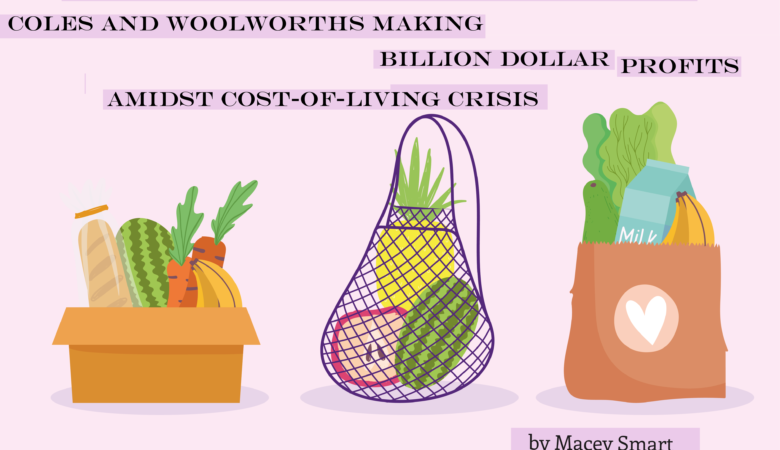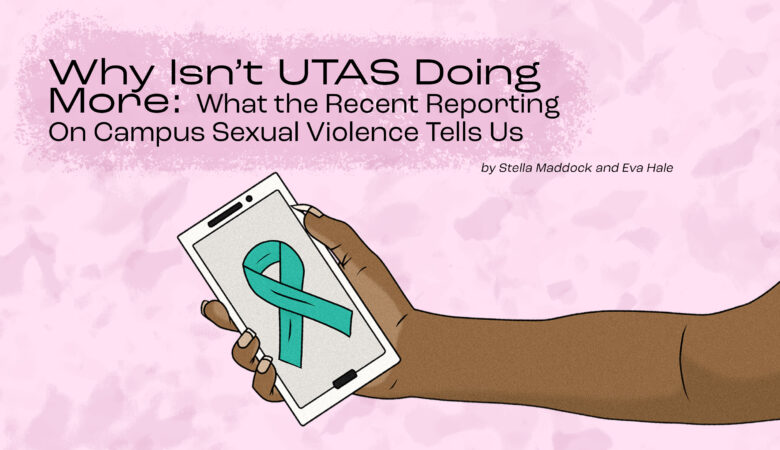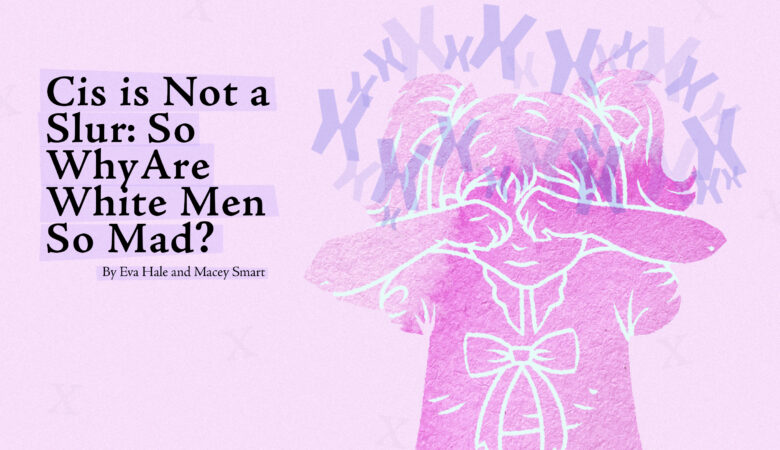Martha Summers is the butch icon, architect and artist responsible for the lesbian internet’s new favourite invention, the ‘TOOLbelt’. Part strap on harness, part tool belt, the handmade leather, functional-art-piece designed by Martha is available to order on her online store. Togatus’ Chelsea Menzie got the chance to hear from Martha about her latest project, lesbian stereotypes and butch identity.
Chelsea: Hi Martha! You mentioned on your Instagram that you’ve been working on your latest project TOOLbelt for at least nine months, what was that process like for you and how did inspiration strike you?
Martha: Hello! So the reason it took so long was actually just that I haven’t had much free time recently. I started work on it last September and then I just got really busy and had to put it in a box for about 6 months. I have my day job as an architect, and was also working on some of my own queer architectural projects outside of work too. Last winter I was designing a LGBTQ+ Community Centre in London, and at the start of this year I designed an exhibition of LGBTQ+ archival ephemera called Out & About, which was in the Barbican Centre, also in London. Then I got Covid, and I also have endometriosis so spend a lot of time in bed suffering with that so it was a long time before I was able to pick it back up out of the box and finish it!
What was quite nice about that though was that when I started working on the piece, I was really feeling quite low, and detached from my queerness. After a year and a half of the pandemic, I was feeling very negatively about myself in that- because being locked down I think so many of us were only ever experiencing the hard parts of being queer, and none of the collective joy or desire. I had the idea for the piece in 2018, which was a very different time for me. I’d only been out for two years and my life was sort of a constant mess but also filled with exploration and gigantic feelings and also lots of joy. I think I originally genuinely thought of it as like a practical item where you could have a number of different dildo sizes to hand to switch in and out! Haha. Which I still might make that version to be honest.. Anyway, when I actually started making it at the end of 2021, I almost felt like a bit of a fraud, like does this work even reflect my sense of self anymore…and who even is “myself” anymore. I also got diagnosed with autism during the pandemic so I was also wrangling with that and a lot of re-understanding of myself at the time.
But then I had this like 6 months of working on these great queer community projects- the community centre, and the exhibition and I reconnected with my queer self in really positive ways- and in new ways! And I’d been doing a lot more hands on construction kind of stuff too, I went on a women’s carpentry course in Wales in May. So when I picked the project back up to finish it it felt like something had shifted and I felt a different connection to the work I was making.
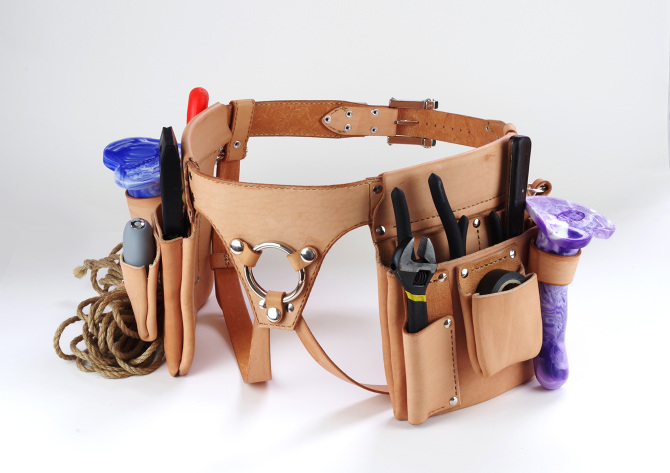
I like that you called the TOOLbelt more than a “three dimensional joke” can you speak a little bit about the dichotomy between the humour and the functionality of the piece?
Well basically it started as a sort of joke idea. I think I wrote a tweet about it that got like 7 likes. I just thought, that’s a funny, very lesbian combination, and I couldn’t believe it hadn’t been done before, even as like an illustration or something. And that’s partly why I made it, I just sort of felt like, this really just SHOULD exist.
But I think as I worked on it, and also since it’s been out in the world and I’ve seen what it means to people I’ve reflected on the deeper meanings that it has. I think first off it’s a piece of work that speaks to a group of people who are basically never marketed to or catered for by mass media or market. Butch dykes of the kind that like this piece, are I think generally seen as just too degenerate by heteronormative society to really ever see themselves reflected in TV shows, mainstream art…anything like that etc. And I think making something that is sexual and highlights the sexiness of gender nonconforming people. Speaking from my own experience and gender- being a woman who looks like I do, and loves tools and making stuff etc has really resonated with a lot of people who rarely get to resonate with anything. I don’t think it’s quite the same thing as “representation” per se, I think it’s more like a sort of collective identifying with one another, like a sort of global dyke nod. I feel that especially because the posts on twitter and Instagram haven’t really left queer online circles I haven’t received any homophobic messaging or anything like that. I think that’s also because the work speaks to a really specific subset of people in our community. What’s nice about that is that I think those people rarely see things that are just for them and made by someone who is one of them.
What’s nice about that is that people rarely see things that are just for them and made by someone who is one of them
Martha Summers
So I think on one level it says- tool belts and queer people who wear them are hot and sexy- and that’s a playful, affirming narrative that a lot of people find kinky and exciting. But the second layer to it, which is a bit more personal is that I think it frames a strap-on harness as a simple utilitarian device. That for some people a strap-on harness is just an utterly everyday tool/ holders of tools, to facilitate a particular act or the creation of something. It certainly is that way for me. At times it has been different, when I was younger, wearing a harness itself created a special feeling and an excitement. But now for me, there honestly is little difference between a toolbelt and harness, and I see that as a fine thing. And if you think about it, all strap-harnesses are already toolbelts for the carrying of one (sometimes two!) tools.
This piece playfully underscores lesbian humour I think for a lot of people in the community. There is a stereotype of lesbians and butches especially as ‘hands on’ in some settings (or ready to get into a DIY project for instance haha)! How much does playing on stereotypes come into your art?
I mean, I am an architect and I have been fuelled by the desire to make things since I was a tiny child, so being into DIY, construction, liking tools…all these things are part of the fabric of who I am. I think I’m conscious that the spectrum of butch identity is very wide- including both how people express and understand that identity and also what their gender may be. I think there are people who identity as butch out there that I probably have absolutely nothing in common with other than use of that term. I think that the work has been enjoyed by a wide variety of queer people- many of whom aren’t butch, or lesbian, which I think is wonderful, if a bit overwhelming!
I think basically its Dyke Camp, to reference this great piece of writing. I think stereotypes can be harmful and reductive in the wrong hands, and sometimes that includes queer people, who can sometimes be reductive and very objectifying of butches. I’ve often felt like I’m on the receiving end of a very weird set of expectations and projections just because I have like short hair and am wearing a nice jacket. So it’s like, a handle with care situation. I can make a joke about this stereotype, or this culture because it is my culture, and I know that there is much more to all of us than being like, a sexy person in a toolbelt. But also its important to be able to laugh at yourself…and often a lot of queer art can be quite serious (sometimes it needs to be) but I prefer when it’s a bit of a laugh and its joyful and silly like this. It’s camp and doesn’t take itself too seriously and I think that very important! And also its about queer domesticity- a big interest of mine in all my work… something very every day and familiar- which is often where humour can be found.
So, do you envision these stereotypes in your work as reclamation, celebration, acknowledgement of history?
I think there are some foundational texts for me as I was finding my butch identity like stone butch blues of course, the collected Dykes To Watch Out For, more recently the TV show Work In Progress and the drawings of Edith Hammar… but also sort of trawling the archives of all kinds for people who looked like me…maybe felt like me.. I really like in particular a lot of the photos of lesbians by Joan Biren or Donna Gottschalk of women in the 70s in the USA building their own communities, often topless… I could really identity with that desire to like take ownership of your body in that way whilst also physically carving out space and community for yourself, with means that are often kept from you. I feel like there is a real independence that comes with being butch or similarly gender non-conforming- and its not really through choice…but there’s always felt like there was a similar independence in my own desire to build and make things. To be able to make and maintain your own living space, for example- but also being someone who has to build their own sense of self and identity from scattered, fragmentary reference points.
So basically I think there is connection between butch identity and building/making that is really about independence and incredible strength and perseverance. For me it has nothing to do with binary ideas of “masculine” and “feminine” activities (and I do not use either of those terms to describe myself), but about what it means to be non-conforming, to be on the margins, and to have to DIY a lot more than just stuff around the house!
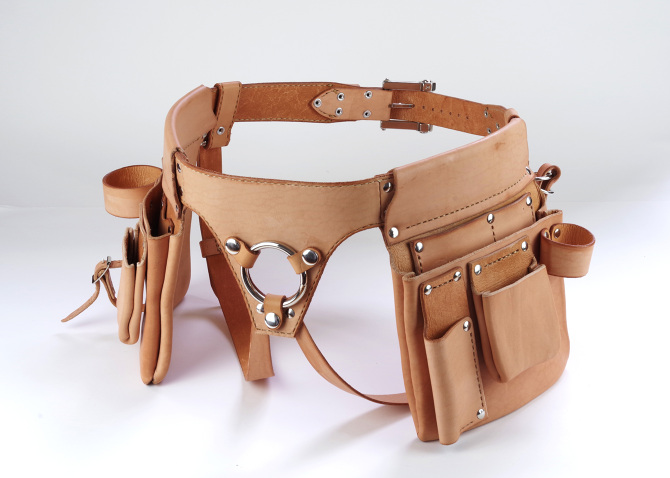
To me this project really leans into the history of the working class lesbian too, is this an area of interest to you and if so why?
Yes it is.. I am not from a wealthy background at all, and I think part of what informs my artistic practice is growing up with a mum who always found a way to make things out of nothing. I remember when I started Architecture School I made my first model out of a cereal box because it literally did not cross my mind/ I didn’t have the option to spend money on raw materials…I got laughed at…but I still kind of standby it to be honest! A lot of my other projects have themes of mending in them too for similar reasons.
I think my background is also why there are a lot of domestic themes in my work- that ultimately all my work is a longing love letter to the possibly unattainable ideal of stable queer domesticity.
I think that it’s also a way to like try and help me marry my upbringing and my life now, as someone who is now university educated and got themselves a professional career, I don’t really feel at home in either class culture any more, but I feel a great deal of melancholy, fondness and homesickness for the world I grew up in- even though it was absolutely not a queer environment.
I also grew up with a father who did a lot of DIY and the garden shed was sort of like this forbidden dreamland to me where I would sneak in and steal tools that I wasn’t allowed to use- being estranged from that parent has often made my love of that world feel very tortured and painful as an adult- and I think deep down- maybe it sounds silly- but making this very queer piece of artwork that celebrates the sort of DIY, hands-on butch on my own terms- has probably been very healing in a way I simply have not divulged to anyone until now. So there’s an exciting exclusive for you haha!
And also- for similar reasons…I feel very touched by all the lesbians and queer people in the trades who messaged me to say how much they loved the piece in particular- that absolutely means the most to me. I know what it is like to be a queer person, specifically a butch woman in construction, and how rare it is to be treated with respect- making something that feels so affirming and joyful to those people in particular feels like an amazing honour.
Readers can find more of Martha’s work on her website www.marthasummers.co.uk and on Instagram @marfsummers. She has sets of postcards depicting her TOOLbelt available for £4.50 each- with more details online. And for those wishing to own their own toolbelt harness, Martha is currently getting set up to be able to produce more- with a waiting list you can join to register your interest. Martha also has a paypal link on her Instagram for anyone who wishes to tip in support of her work!

